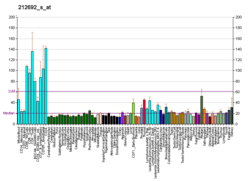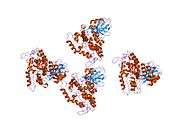Lipopolysaccharide-responsive and beige-like anchor protein is a protein that in humans is encoded by the LRBA gene.[5][6][7]
Patients with Chediak-Higashi syndrome (CHS1; MIM 214500) suffer from a systemic immunodeficiency involving defects in polarized trafficking of vesicles in a number of immune system cell types. In mouse, this syndrome is reproduced in strains with a mutation in the 'beige' gene that results in proteins lacking the BEACH (beige and CHS1) domain and C-terminal WD repeats. LRBA contains key features of both beige/CHS1 and A kinase anchor proteins (AKAPs; see MIM 602449).[supplied by OMIM][7]
Further reading
- Ewing RM, Chu P, Elisma F, et al. (2007). "Large-scale mapping of human protein–protein interactions by mass spectrometry". Mol. Syst. Biol. 3 (1): 89. doi:10.1038/msb4100134. PMC 1847948. PMID 17353931.
- Olsen JV, Blagoev B, Gnad F, et al. (2006). "Global, in vivo, and site-specific phosphorylation dynamics in signaling networks". Cell. 127 (3): 635–48. doi:10.1016/j.cell.2006.09.026. PMID 17081983.
- Gebauer D, Li J, Jogl G, et al. (2005). "Crystal structure of the PH-BEACH domains of human LRBA/BGL". Biochemistry. 43 (47): 14873–80. doi:10.1021/bi049498y. PMID 15554694.
- Ota T, Suzuki Y, Nishikawa T, et al. (2004). "Complete sequencing and characterization of 21,243 full-length human cDNAs". Nat. Genet. 36 (1): 40–5. doi:10.1038/ng1285. PMID 14702039.
- Strausberg RL, Feingold EA, Grouse LH, et al. (2003). "Generation and initial analysis of more than 15,000 full-length human and mouse cDNA sequences". Proc. Natl. Acad. Sci. U.S.A. 99 (26): 16899–903. doi:10.1073/pnas.242603899. PMC 139241. PMID 12477932.
- Dyomin VG, Chaganti SR, Dyomina K, et al. (2003). "BCL8 is a novel, evolutionarily conserved human gene family encoding proteins with presumptive protein kinase A anchoring function". Genomics. 80 (2): 158–65. doi:10.1006/geno.2002.6822. PMID 12160729.
PDB gallery |
|---|
1t77: Crystal structure of the PH-BEACH domains of human LRBA/BGL |







